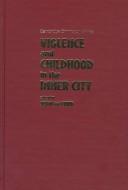| Listing 1 - 2 of 2 |
Sort by
|
Multi
ISBN: 9781400889242 9780691172224 0691172226 Year: 2018 Publisher: Princeton, N.J. Princeton University Press
Abstract | Keywords | Export | Availability | Bookmark
 Loading...
Loading...Choose an application
- Reference Manager
- EndNote
- RefWorks (Direct export to RefWorks)
New York City's Lower East Side, long viewed as the space of what Jacob Riis notoriously called the "other half," was also a crucible for experimentation in photography, film, literature, and visual technologies. This book takes an unprecedented look at the practices of observation that emerged from this critical site of encounter, showing how they have informed literary and everyday narratives of America, its citizens, and its possible futures. Taking readers from the mid-nineteenth century to the present, Sara Blair traces the career of the Lower East Side as a place where image-makers, writers, and social reformers tested new techniques for apprehending America--and their subjects looked back, confronting the means used to represent them. This dynamic shaped the birth of American photojournalism, the writings of Stephen Crane and Abraham Cahan, and the forms of early cinema. During the 1930s, the emptying ghetto opened contested views of the modern city, animating the work of such writers and photographers as Henry Roth, Walker Evans, and Ben Shahn. After World War II, the Lower East Side became a key resource for imagining poetic revolution, as in the work of Allen Ginsberg and LeRoi Jones, and exploring dystopian futures, from Cold War atomic strikes to the death of print culture and the threat of climate change. How the Other Half Looks reveals how the Lower East Side has inspired new ways of looking-and looking back-that have shaped literary and popular expression as well as American modernity.
History --- Art --- Documentary photography --- Street photography --- Slums --- Inner cities --- Photography, Artistic --- Jews --- Lower East Side (New York, N.Y.) --- Social life and customs

ISBN: 0521583268 0521587204 0511571011 9780511571015 9780521583268 9780521587204 Year: 1997 Publisher: Cambridge Cambridge University Press
Abstract | Keywords | Export | Availability | Bookmark
 Loading...
Loading...Choose an application
- Reference Manager
- EndNote
- RefWorks (Direct export to RefWorks)
The contributors to this book believe that something can be done to make life in American cities safer, to make growing up in the urban ghettos less risky, and to reduce the violence that so often permeates urban childhoods. They consider why there is so much violence, why some people become violent and others do not, and why violence is more prevalent in some areas. Both biological and psychological characteristics of individuals are considered. The authors also discuss how the urban environment, especially the street culture, affects childhood development. They review a variety of intervention strategies, considering when it would be appropriate to use them and towards whom they should be targeted. Drawing upon ethnographic commentary, laboratory experiments, historical reviews, and program descriptions, this book presents a variety of opinions on the causes of urban violence and the changes necessary to reduce it.
Violence --- Inner cities --- Children and violence --- Violence in children --- City children --- Urban youth --- Quartiers pauvres --- Jeunes en milieu urbain --- Age group sociology --- criminele psychologie --- Orthopedagogics --- orthopedagogiek --- jongerencriminaliteit --- Criminology. Victimology --- Children in cities --- Urban children --- City dwellers --- Youth --- Children --- Urban teenagers --- Criminologie --- Médiation --- Social Sciences --- Sociology --- Abus a l'egard d'enfants --- Agression criminelle --- Enfants victimes --- Neuropsychologie --- Prevention --- Psychologie du developpement --- Violence urbaine
| Listing 1 - 2 of 2 |
Sort by
|

 Search
Search Feedback
Feedback About UniCat
About UniCat  Help
Help News
News